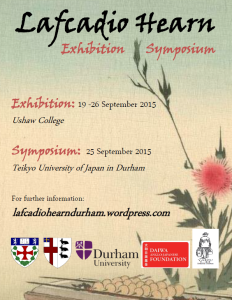 An exhibition and symposium this September will celebrate the work of a little-known but influential literary genius and traveller. Lafcadio Hearn was born in Greece, grew-up in Dublin, educated at Ushaw College in Durham, and ended his years as Professor of English at the Imperial University in Tokyo, under the name Koizumi Yakumo. During his worldly career he published a large body of travel-writing and essays about Japan and elsewhere, as well as translations and stories.
An exhibition and symposium this September will celebrate the work of a little-known but influential literary genius and traveller. Lafcadio Hearn was born in Greece, grew-up in Dublin, educated at Ushaw College in Durham, and ended his years as Professor of English at the Imperial University in Tokyo, under the name Koizumi Yakumo. During his worldly career he published a large body of travel-writing and essays about Japan and elsewhere, as well as translations and stories.
Ushaw College will be hosting an exhibition on afternoons from 19th to 26th September, along with talks about the exhibition. On 25th September a one-day conference in Durham will examine the legacy of this significant literary intellectual; the conference features a keynote lecture by the Irish novelist, Paul Murray. For more information about the exhibition and conference, and to find out more about Lafcadio Hearn, follow the dedicated website or email the conference organiser, Professor Stephen Regan (stephen.regan@durham.ac.uk).
Who was Lafcadio Hearn?
Lafcadio Hearn, known in Japan as Koizumi Yakumo, was born in 1850 on the Greek island of Levkás. He grew up in Dublin and was educated at Ushaw College, Durham, where his name appears in college records as Patrick Hearn. He left Ireland for the United States at the age of 19, settling in Cincinnati and working at various menial jobs and then on The Trade List, before joining The Cincinnati Enquirer as a reporter. While in Cincinnati he translated stories by Théophile Gautier and Gustave Flaubert. In 1877, he moved on to New Orleans, and from 1887 to 1889 he was in the West Indies on assignment for Harper’s Magazine, which resulted in Two Years in the French West Indies (1890) and a novel Youma (1890), dealing with the insurrection against slavery. In 1890 Hearn traveled to Japan for Harper’s. He eventually gave up his work with the magazine and worked as a schoolteacher in Izumo in south-western Japan. There he met and married Koizumi Setsu. In 1895 he became a Japanese subject, taking the name Koizumi Yakumo, Koizumi being his wife’s family name. His articles on Japan were published in The Atlantic Monthly and in several newspapers in the United States. These essays and others were collected and published as Glimpses of Unfamiliar Japan (1894). From 1896 to 1903, Hearn was Professor of English Literature at the Imperial University of Tokyo. Four books written at this time reflect his deep interest in the literature and culture of Japan: Exotics and Retrospective (1898), In Ghostly Japan (1899), Shadowings (1900), and A Japanese Miscellany (1901). Kwaidan (1904), published the year he died, includes Hearn’s stories of the supernatural.



The film adaptation of his book ” Kwaidan: Stories and Studies of Strange Things” was made into a very successful film by Masaki Kobayashi in 1964 called “Kwaidan”. It won the Special Jury Prize at the 1965 Cannes Film Festival and an Academy Award nomination for Best Foreign Language Film in 1965. Worth seeking out.
LikeLike
How interesting – just seen the trailer on Youtube (https://www.youtube.com/watch?v=XG5mvupo9Wc). A bit eerie, and amazing camerawork.
LikeLike